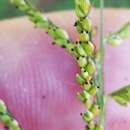Distribution in Egypt
provided by Bibliotheca Alexandrina LifeDesk
Nile and Mediterranean regions, eastern desert.
- author
- BA Cultnat
- provider
- Bibliotheca Alexandrina
Global Distribution
provided by Bibliotheca Alexandrina LifeDesk
Tropical Africa, tropical Asia, introduced weed throughout the tropics.
- author
- BA Cultnat
- provider
- Bibliotheca Alexandrina
Comments
provided by eFloras
A good fodder grass whose grain has been used as food in times of famine.
- license
- cc-by-nc-sa-3.0
- copyright
- Missouri Botanical Garden, 4344 Shaw Boulevard, St. Louis, MO, 63110 USA
Description
provided by eFloras
Annuals; culm ascending, 10-30 cm above creeping base, nodes hairy, 1.2-2.5 mm in diam. Blades
hispid, 1-9 cm long, 4-12 mm wide, cordate and ciliate on undulate margins at base; sheaths ciliate on
margins, shorter than internode; ligule ca. 1 mm long. Inflorescence of racemose racemes, racemes 3-
15, usually alternate on main axis, 0.5-3 cm long; rachis usually scabrid and pilose; pedicel with a fewweak long hairs. Spikelets paired, ovate, pale, crowded on one side of rachis, turgid, ca. 2 mm long, 1
mm wide, glabrous; lower glume minute, 1/4-1/5 as long as spikelet, membranaceous, truncate or
rounded, veinless or obscurely 1-veined; upper glume ovate, acute, 5-7-veined; lower lemma 5-veined,
paleate, palea oblong, acute, nearly as long as spikelet; upper lemma obovate, apiculate, minutely rugose;
anther ca. 0.8 mm long.
- license
- cc-by-nc-sa-3.0
- copyright
- Missouri Botanical Garden, 4344 Shaw Boulevard, St. Louis, MO, 63110 USA
Description
provided by eFloras
Annual, usually with decumbent stems rooting at the nodes; culms 15-60 cm high. Leaf-blades narrowly lanceolate to lanceolate, 2-7 cm long, 3-15 mm wide. Inflorescence of 5-15 racemes on an axis 1-8 cm long; racemes 14 cm long, bearing paired spikelets crowded on a triquetrous rhachis with hirsute pedicels. Spikelets narrowly ovate to broadly elliptic, 1.5-2.2 mm long, glabrous, acute, without a stipe; lower glume one eighth to a quarter the length of the spikelet, hyaline, clasping, truncate (sometimes a little longer and broadly ovate); upper lemma rugose, subacute, mucronulate.
- license
- cc-by-nc-sa-3.0
- copyright
- Missouri Botanical Garden, 4344 Shaw Boulevard, St. Louis, MO, 63110 USA
Distribution
provided by eFloras
Distribution: Pakistan (Sind, Baluchistan, Punjab & N.W.F.P.); tropical Asia; introduced throughout the tropics.
- license
- cc-by-nc-sa-3.0
- copyright
- Missouri Botanical Garden, 4344 Shaw Boulevard, St. Louis, MO, 63110 USA
Synonym
provided by eFloras
Panicum reptans L., Syst. Nat. ed. 10, 2: 870. 1759.
Urochloa reptans (L.) Stapf, Fl. Trop. Afr. 9: 601. 1966; Veldkamp, Blumea 41: 427. 1996.
- license
- cc-by-nc-sa-3.0
- copyright
- Missouri Botanical Garden, 4344 Shaw Boulevard, St. Louis, MO, 63110 USA
Physical Description
provided by USDA PLANTS text
Annuals, Terrestrial, not aquatic, Stems nodes swollen or brittle, Stems geniculate, decumbent, or lax, sometimes rooting at nodes, Stems mat or turf forming, Stems caespitose, tufted, or clustered, Stems terete, round in cross section, or polygonal, Stem nodes bearded or hairy, Stem internodes solid or spongy, Stem internodes hollow, Stems with inflorescence less than 1 m tall, Stems, culms, or scapes exceeding basal leaves, Leaves mostly cauline, Leaves conspicuously 2-ranked, distichous, Leaves sheathi ng at base, Leaf sheath mostly open, or loose, Leaf sheath smooth, glabrous, Leaf sheath hairy, hispid or prickly, Leaf sheath and blade differentiated, Leaf blades linear, Leaf blades 2-10 mm wide, Leaf blades 1-2 cm wide, Leaf blades mostly flat, Leaf blades mostly glabrous, Leaf blades more or less hairy, Ligule present, Ligule a fringed, ciliate, or lobed membrane, Ligule a fringe of hairs, Inflorescence terminal, Inflorescence solitary, with 1 spike, fascicle, glomerule, head, or cluster per stem or culm, Inflorescence a panicle with narrowly racemose or spicate branches, Inflorescence branches more than 10 to numerous, Inflorescence branches 1-sided, Flowers bisexual, Spikelets pedicellate, Spikelets sessile or subsessile, Spikelets dorsally compressed or terete, Spikelet less than 3 mm wide, Spikelets with 1 fertile floret, Spikelets with 2 florets, Spikelet with 1 fertile floret and 1-2 sterile florets, Spikelets paired at rachis nodes, Spikelets all alike and fertil le, Spikelets bisexual, Spikelets disarticulating below the glumes, Spikelets secund, in rows on one side of rachis, Rachilla or pedicel glabrous, Glumes present, empty bracts, Glumes 2 clearly present, Glumes distinctly unequal, Glumes equal to or longer than adjacent lemma, Glume surface hairy, villous or pilose, Glumes 3 nerved, Lemma coriaceous, firmer or thicker in texture than the glumes, Lemma becoming indurate, enclosing palea and caryopsis, Lemma 5-7 nerved, Lemma glabrous, Lemma rugose, with cross wrinkles, or roughened, Lemma apex acute or acuminate, Lemma awnless, Lemma mucronate, very shortly beaked or awned, less than 1-2 mm, Lemma straight, Palea present, well developed, Palea longer than lemma, Stamens 3, Styles 2-fid, deeply 2-branched, Stigmas 2, Fruit - caryopsis.

